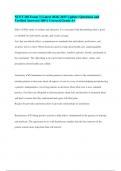NUFT 202 Exam 3 (Latest 2024/ 2025 Update) Questions and Verified Answers| 100% Correct| Grade A+ Ethics ✔✔the study of conduct and character. It is concerned with determining what is good or valuable for individuals, groups, and society at large. Acts that are ethical reflect a commitmen t to standards that individuals, professions, and societies strive to meet. When decisions must be made about health care, understandable disagreement can occur among health care providers, families, patients, friends, and people in the community. The righ t thing to do can be hard to determine when ethics, values, and perceptions about health care collide. Autonomy ✔✔Commitment to include patients in decisions; refers to the commitment to include patients in decisions about all aspects of care as a way of acknowledging and protecting a patient's independence. Involving patients in decisions about their care is now standard practice. Providers are obligated to inform patients about risks and benefits of treatment plans and then to ensure that they understan d and agree with their plan. Respect for provider autonomy refers to provider relationships to institutions. Beneficence ✔✔Taking positive actions to help others; fundamental to the practice of nursing and medicine. The agreement to act with beneficen ce implies that the best interests of the patient remain more important than self -interest. Nonmaleficence ✔✔Avoidance of harm or hurt; Maleficence refers to harm or hurt; thus nonmaleficence is the avoidance of harm or hurt. In health care, ethical prac tice involves not only the will to do good, but an equal commitment to do no harm. Justice ✔✔Being fair; refers to fairness. It is used most often in discussions about access to health care resources, including the just distribution of resources. The ter m just culture refers to the promotion of open discussion without fear of recrimination whenever mistakes, especially those involving adverse events, occur or nearly occur. Fidelity ✔✔Agreement to keep promises; also refers to the unwillingness to abando n patients regardless of the circumstances, even when personal beliefs differ as they may when dealing with drug dealers, members of the gay community, women who received an abortion, or prisoners. Code of nursing ethics ✔✔- A set of guiding principles t hat all members of a profession accept - Helps professional groups settle questions about practice or behavior - Includes advocacy, responsibility, accountability, and confidentiality Social networking ✔✔presents ethical challenges for nurses; can be a s upportive source of information about patient care or professional nursing activities. The risk to patient privacy is great. Posting a photo with no identifiers should not be practiced, as sometimes, the patient can still be identified. Becoming friends wi th patients may cloud your ability to remain objective. Workplace policies will guide your decisions in engaging with social media. ANA code of ethics ✔✔The American Nurses Association (ANA) code of ethics provides a foundation for professional nursing. A code of ethics can be defined as a collective statement about the group's expectations and standards of behavior. The ANA established the first code of nursing ethics decades ago. The ANA reviews and revises the code regularly to reflect changes in p ractice. However, basic principles of responsibility, accountability, advocacy, and confidentiality remain constant. Advocacy ✔✔refers to the support of a particular cause. As a nurse you advocate for the health, safety, and rights of patients, including their right to privacy and their right to refuse treatment. Responsibility ✔✔refers to willingness to respect obligations and to follow through on promises. Accountability ✔✔refers to the ability to answer for one's own actions. Standards are set by The Joint Commission and the ANA. Health care facilities have compliance officers who are responsible for making sure that the institution remains in compliance with standards and regulations. confidentiality ✔✔The Health Insurance Portability and Accou ntability Act of 1996 (HIPAA) mandates protection of the patient's personal health information. Your patient is about to undergo a controversial orthopedic procedure. The procedure may cause periods of pain. Although nurses agree to do no harm, this proc edure may be the patient's only treatment choice. This example describes the ethical principle of: A. autonomy. B. fidelity. C. justice. D. nonmaleficence. ✔✔Answer: D Rationale: Sometimes to improve a patient's condition, it is necessary to perform a procedure t hat will cause pain for the patient. The nurse must weigh the benefits and the risks with the patient in his or her quest to do no harm. Value ✔✔A value is a personal belief about the worth of a given idea, attitude, custom, or object that sets standards that influence behavior. Values clarification ✔✔Ethical dilemmas almost always occur in the presence of conflicting values. To resolve ethical dilemmas, one needs to distinguish among values, facts, and opinion. you learn to tolerate differences in a w ay that often (although not always) becomes the key to the resolution of ethical dilemmas. Deontology ✔✔proposes a system of ethics that is perhaps most familiar to health care practitioners. Deontology defines actions as right or wrong based on their "r ight-making characteristics," such as fidelity to promises, truthfulness, and justice. Deontology depends on a




